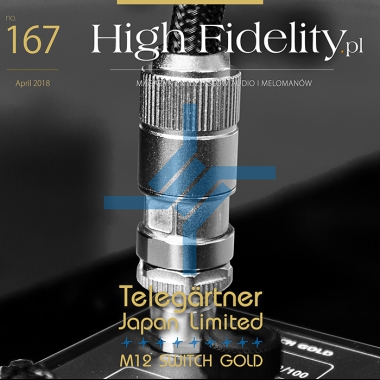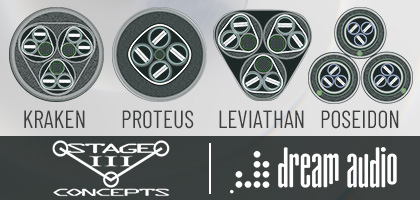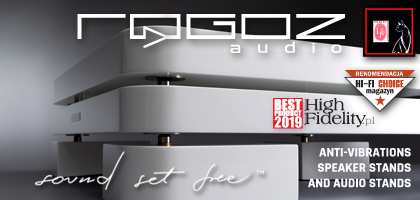No. 260 January 2026
- COVER REVIEW: EVERSOLO DAC-Z10 ⸜ digital-to-analog converter/preamplifier » CHINA
- AWARDS: BEST OF 2025 according to the HIGH FIDELITY » WORLDWIDE
- KRAKOW SONIC SOCIETY № 154: CRYSTAL DISC • AudioNautes Recordings » ITALY - JAPAN - POLAND
- REVIEW: FEZZ AUDIO Luna Mini Evo ⸜ integrated amplifier » POLAND
- REVIEW: GARLUBIDOR Divinity ⸜ digital-to-analog converter » CHINA
- REVIEW: XAVIAN Natura Unica ⸜ loudspeakers • stand-mounted » CZECH
- MICRO-REVIEW: ACOUSTIC REVIVE QSB-3810 ⸜ spike pads » JAPAN


|

|
|
Audiophile Speaker Set-up Released: 02.02.2018

René Laflamme during High End Show 2017 in Munich with the „High Fidelity” sticker informing about our Best Sound • High End 2017 You may know René Laflamme for example from photos from the High End Show in Munich, because for the last two years, the room he prepared, received the Best Sound award from us for one of the best sounds of the exhibition. And it was not just coincident. René is one of the most experienced sound engineers, who started his career in the audio world as the owner and engineer of Fidelio Musique (more HERE | Polish| and HERE | Polish|). The perfect sound of his records caught the attention of the audiophile community. Suffice to say that in addition to recognition related to his recordings, he was also one of the founders of the Kronos company, offering excellent turntables (more HERE | HERE | Polish|). In 2015, however, something new happened - along with Mr. Andre Perry, PHD of musicology, producer, engineer, composer, and also founder of the Le Studio (Morin Heights) recording studio, where such artists as The Police, Sting, Asia, Cat Stevens, Rush , Bee Gees, David Bowie, Keith Richards and others recorded their albums, founded the 2xHD label. We met back then on a corridor in Munich and it was clear that for René it was a new, exciting chapter of his professional life (you can find our Show coverage HERE). The company aimed at publishing recordings in the form of digital files in the highest possible quality - hence the name 2xHD. Since at that time Fidelio 'HD' still meant 24/96 PCM signal, it is not difficult to count that the name was about recordings with 24/192 resolution. 
The basic tool at 2xHD I Nagra-T tape recorder It has quickly changed for the better. If we check current catalog of this label, you will see that it also features DXD and DSD recordings up to DSD256 which means a sampling frequency of 11.2896 MHz. The heated discussion about what is the upper PCM sampling frequency needed to get the best quality, and now also about what the upper DSD signal sampling frequency is the best, is still going on, both in the pro world, i.e. among sound engineers and in audiophile world. The prevailing view among the former is that an increase in sampling frequency over the standard for DSD (and SACD) of 2.8224 MHz (64 times more than for CD) does not bring any benefits, because above 20 kHz this type of signal contains mainly noise. | DSD256 I agreed with this view for a long time. Until a few years ago I heard the DSD128 (5.6 MHz) recordings from Opus3, and last year I saw how the Japanese approached it. Then in one of the issues of the top Japanese high-end magazine, the quarterly "Stereo Sound", appeared an extensive article about this sub-format, with measurements and charts, and the magazine produced and released a special sampler, which contained the same recordings in various formats and sampling frequencies, including DSD-DSF 11.22896 MHz. The measurements clearly showed that each increase in the sampling frequency of the DSD signal REDUCED noise in the frequency range by a dozen or so dB, and all the noise was shifted higher in the band by an octave. At four times higher frequency, the noise starts to be felt four octaves higher! - It's pure mathematics. And this means that filters that eliminate it can be gentle and start working very high, reducing phase shifts in the basic band. 
Octopus (octobass), an instrument used on 2xFD Fusion sampler for bass presentation; it goes down as deep as 28 Hz, and its harmonic down to 20 Hz These theoretical postulates were confirmed by listening sessions. DSD128 and DSD256 recordings sound better than DSD64. Period. They do not have a warmed top end, which is often confused with "analogue" sound, are more precise and resolving, and at the same time retain all the advantages of DSD signal, such as softness, naturalness and saturation. Recently, strong support from the theoretical side the DSD recordings with a higher sampling frequency received from Keith Howard, who looked at them in a comprehensive article entitled DSD Downloads published in the respected „HIFICRITIC”, run by Martin Colloms, known among others from the excellent textbooks of column design, and by Paul Messenger, long-time editor of "Hi-Fi News", "Hi-Fi Choice", "Stereophile" magazines. Howard, known for precise, perfectly documented technical articles published, among others in "Stereophile" and "Hi-Fi News" magazines, proves that DSD256 recordings simply measure better. With DSD64, some recordings he studied had a limited frequency response, which made it impossible to transmit the energy of the instruments from their entire band, and with all of them it was clear that "the ultrasonic content of the recordings was masked by quantum noise at DSD64" (Keith Howard, DSD Downloads, „HIFICRITIC” 2017, Volume 11, No. 4, p. 38). He sums up his observations as follows: "Higher cut-off frequency, while keeping all basic parameters unchanged, leads to reduced phase distortion and shortens the impulse response time, where the latter feature is important, because it is the impulse response free from oscillation before and after the pulse (" minimum-phase impulse response ") that is one of the most commonly cited arguments for the predominance of this DSD format over PCM" (p. 39). You can argue, discuss, but for me the matter is simple: DSD128 and DSD256 files sound better than DSD64. The first to discover this phenomenon were the Japanese. Because I know how much we, people of the West, owe them in regard to how we think about audio - they pointed out the importance of audio cabling, reduction of vibrations, they brought tubes "back to life", etc. - I can not pretend that the matter is not worth further research. At the moment, you can probably say that the higher quality of DSD 256 signal and sound is indisputable. It has been confirmed from the theoretical side, through the appropriate theory and measurements, as well as from practical, through auditions. Therefore, the only discussion left is whether such changes are audible in the given system and whether they are important for the listener. I can hear them perfectly and I care about them. | AUDIOPHILE SPEAKER SET-UP 
René Laflamme, who with Andre Perry recently released a sampler called Audiophile Speaker Set-up also believes that the signal with higher sampling frequencies is more similar to the analog signal. This is a special release. Firstly, it was released as a file and is available, for example, at HDTRACKS. In the first week after the release, it was one of the bestsellers of the portal, where it was also awarded the Engineer Picks. Secondly, the material for this release was encoded in DSD-DSF 11.2896 MHz and comes from analog master tapes and DSD. And thirdly, it is incredibly elaborate, in every detail, guide to the loudspeaker setup process. |
 RENÉ LAFLAMME WOJCIECH PACUŁA: Do you believe that one can re-create exact image and space in home audio system? 
You can not miss even one step. If, for example, you don't do the step 1 (Bass) you can do all the rest very well but the end results will miss energy and extension in the bass. Or if you don't level your speakers you will never have a pin point imaging. Or If you don't address some first reflection or resonance in your room you will have coloration that make a big difference in the results. How do you record space? How microphones change it? Most rock or pop music need to be recorded in a studio (1) and sound better recorded this way. Some engineers sometimes try to record rock or Jazz music in a classical way and the end results have no energy with way too much ambiance. But when the style of music can match a simple two microphones approach it is best option. Better timber, realistic imaging and dynamics. Most of that album here is made with two microphones. 
One of the illustrations presenting the placement of instruments in the Pink Panther theme What is the biggest problem with home systems these days? What's the biggest problem with recordings today? 
An illustration helping to find a proper toe-in I noticed that you added the word “Fusion” to 2xHD logo – what does it mean? In the constant evolution of its proprietary mastering process, 2xHD has progressed to a new phase called 2xHD FUSION, integrating the finest analog, with state-of-the-art digital technology. The resulting signal is then transferred into high resolution formats by recording it in DSD 11.2 MHz using the Merging Technologies Horus A to D converter. All analog and digital cables that are used are state of the art. The 2xHD FUSION mastering system is powered by a super capacitor power supply, using a new technology that lowers the digital noise found in the lowest level of the spectrum. A vacuum tube NAGRA HDdac (DSD) is used as a reference digital playback converter in order to A and B with the original analog master tape, permitting the fusion of the warmth of analog with the refinement of digital.  | ALBUM The album in question is titled Audiophile Speaker Set-up, and its cover offers two more pieces of information: „From Analogue and DSD Masters” and „Great Sampling Tracks Included”. There are 69 tracks on it divided into several groups. 
System used in the 2xHD mastering and recording studios 1| Tracks 2 to 31 are examples of various recordings, selected for their unique tonality, dynamics and soundstage depth. This is a very extensive guide, actually a manual for setting up an audio system, in which a descriptive part with drawings for individual tracks and their groups is an integral part of the album, just as important as the recordings themselves. We can literally see where the individual instruments should be in space in front of us, find out how they should sound, and so on. In my opinion, this is the best release/tool of this type on the market, based on many years of experience of practitioners both in the recording studio and high-end audio, which is an absolute rarity. I think that if it was possible to publish a vinyl with this guide, the world of audio would get even better. And today, for everyone with the appropriate digital-to-analogue converters, this is a must-have. |
About Us |
We cooperate |
Patrons |
|
Our reviewers regularly contribute to “Enjoy the Music.com”, “Positive-Feedback.com”, “HiFiStatement.net” and “Hi-Fi Choice & Home Cinema. Edycja Polska” . "High Fidelity" is a monthly magazine dedicated to high quality sound. It has been published since May 1st, 2004. Up until October 2008, the magazine was called "High Fidelity OnLine", but since November 2008 it has been registered under the new title. "High Fidelity" is an online magazine, i.e. it is only published on the web. For the last few years it has been published both in Polish and in English. Thanks to our English section, the magazine has now a worldwide reach - statistics show that we have readers from almost every country in the world. Once a year, we prepare a printed edition of one of reviews published online. This unique, limited collector's edition is given to the visitors of the Audio Show in Warsaw, Poland, held in November of each year. For years, "High Fidelity" has been cooperating with other audio magazines, including “Enjoy the Music.com” and “Positive-Feedback.com” in the U.S. and “HiFiStatement.net” in Germany. Our reviews have also been published by “6moons.com”. You can contact any of our contributors by clicking his email address on our CONTACT page. |
 



|
   |
main page | archive | contact | kts
© 2009 HighFidelity, design by PikselStudio,
projektowanie stron www: Indecity







 hen René Laflamme, sound engineer at
hen René Laflamme, sound engineer at 


